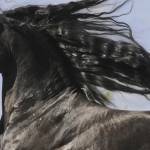Supporting Fertility in Stallions

Stallion fertility can be influenced by nutrition, management, presentation of mares, and the stallion’s age, among other factors. To ensure the best pregnancy rates, managers need to take these points into consideration.
Breeding stallions are working hard, and should therefore be fed like performance horses in a moderate training program. During the spring season, Thoroughbred stallions must produce enough semen for two or three daily breedings. This process requires a lot of energy as well as sufficient levels of dietary protein, fat, vitamins, and minerals. Stallion diets should be based on high-quality forage (hay or pasture). During the breeding season, the addition of energy-dense feed products may be necessary to satisfy calorie requirements for the increased workload of breeding. Grain meals should consist of no more than five pounds of concentrate, so more than one daily feeding may be required. Fortified concentrates designed for breeding stallions will contain the vitamins and minerals necessary for optimal nutrition. While they should not be allowed to become obese, stallions can carry a little more body condition than fit equine athletes in other disciplines.
Handling a stallion is a complex job. The horse must be controlled so that he is not a danger to humans or other horses, but he must still be allowed to express natural vocalizations and actions. Stallions that are harshly disciplined for showing instinctive behavior will sometimes lose interest in breeding because of fear of punishment. This is an important reason why acquiring a stallion is not a good decision for first-time horse owners.
A stallion’s fertility rate is determined by how many mares he serves compared to how many of the mares become pregnant. Ideally, a mare will conceive on her first breeding, and this is most likely to occur if she is presented to the stallion at the peak of her fertility, usually within a few hours on either side of ovulation. Decades ago, the mare had to be brought to the stallion every couple of days when she showed signs of being in heat. With today’s technology, veterinarians can determine the time of ovulation with excellent precision, often eliminating the necessity of breeding more than once per cycle or season. When mares are bred at their most fertile time, the stallion’s pregnancy rate goes up, and he can serve more mares during a single season.
Young stallions should not be booked to as many mares per season as older, more mature stallions. Much of a growing horse’s energy goes toward adding muscle and bone, with a lower level supporting the production of testosterone and semen. Especially if the horse has recently been retired from race training, it may take a while for him to settle into his new role as a sire. Mature stallions can breed two or three mares a day throughout a long breeding season and maintain a good level of fertility, but young stallions should not be expected to handle this level of work.
All management of a stallion should be planned around the fact that sperm production and maturation takes approximately 60 days. For this reason, any changes in feeding or other care should be made well before the breeding season starts.








